
hotline:
17715390137
Tel/Wechat:
18101240246 (Technology)
0512-68565571
Email:mxenes@163.com (Sales Engineer)bkxc.bonnie@gmail.com
Scan the code to follow or search the official account on WeChat:
2D Materials Fronrier After paying attention,
click on the lower right corner to contact us,
Enter enterprise WeChat.
Professional Services Online

Issue 2020.06
1. Earth rotation measured by a chip-scale ring laser gyroscope
2. Generation of spatiotemporal optical vortices with controllable transverse orbital angular momentum
3. Ultrafast, sub-nanometre-precision and multifunctional time-of-flight detection
4. Readout of fluorescence functional signals through highly scattering tissue
5. Light-induced magnetism in plasmonic gold nanoparticles
6. Inverse-designed non-reciprocal pulse router for chip-based LiDAR
7. Ultra-low-threshold continuous-wave and pulsed lasing in tensile-strained GeSn alloys
8. Deep-learning-enabled self-adaptive microwave cloak without human intervention
9.A MHz-repetition-rate hard X-ray free-electron laser driven by a superconducting linear accelerator
1. Earth rotation measured by a chip-scale ring laser gyroscope
Optical gyroscopes are among the most accurate rotation measuring devices and are widely used for navigation and accurate pointing. Since the advent of photonic integrated components for communications, and with their increasing complexity, there has been interest in the possibility of chip-scale optical gyroscopes. Besides the potential benefits of integration, such solid-state systems would be robust and resistant to shock. Here, we report a gyroscope using Brillouin ring lasers on a silicon chip. Its stability and sensitivity enable measurement of Earth’s rotation, representing a major milestone for this new class of gyroscope.
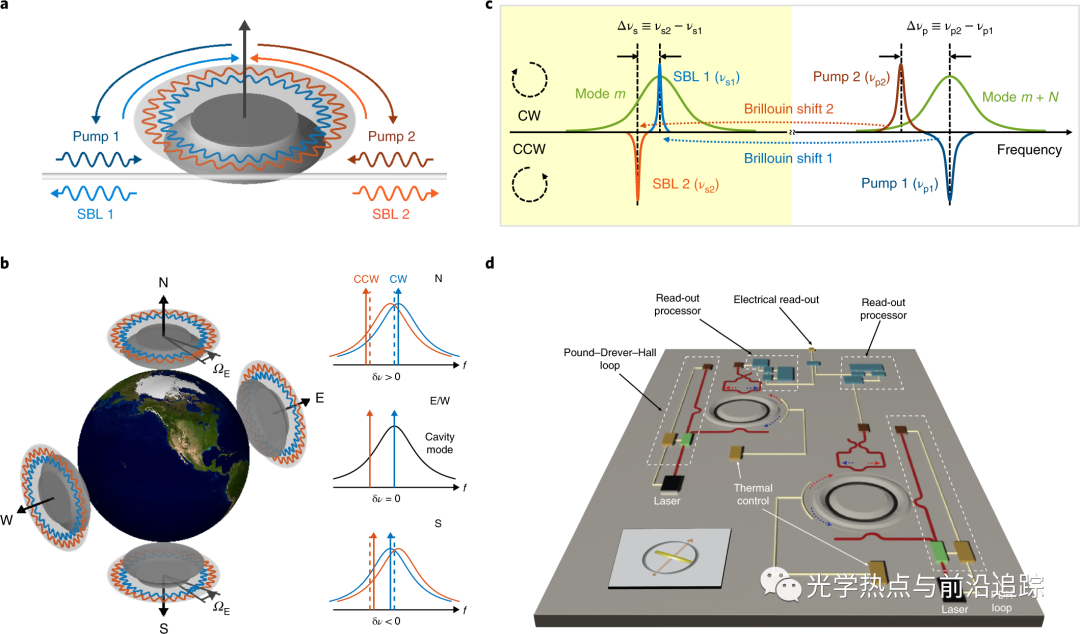
Lai, Y., Suh, M., Lu, Y. et al. Earth rotation measured by a chip-scale ring laser gyroscope. Nat. Photonics14, 345–349 (2020).
论文链接: https://doi.org/10.1038/s41566-020-0588-y
2. Generation of spatiotemporal optical vortices with controllable transverse orbital angular momentum
Today, it is well known that light possesses a linear momentum that is along the propagation direction. Besides, scientists also discovered that light can possess an angular momentum, a spin angular momentum (SAM) associated with circular polarization and an orbital angular momentum (OAM) owing to the azimuthally dependent phase. Even though such angular momenta are longitudinal in general, an SAM transverse to the propagation direction has opened up a variety of key applications. In contrast, investigations of the transverse OAM are rare due to its complex nature. Here, we demonstrate a three-dimensional wave packet that is a spatiotemporal (ST) optical vortex with a controllable purely transverse OAM. Contrary to the transverse SAM, the magnitude of the transverse OAM carried by the ST vortex is scalable to a larger value by simple adjustments. Since the ST vortex carries a controllable OAM uniquely in the transverse dimension, it has strong potential for novel applications that may not be possible otherwise. The scheme reported here can be readily adapted for other spectral regimes and different wave fields, opening opportunities for the study and applications of ST vortices in a wide range of areas.
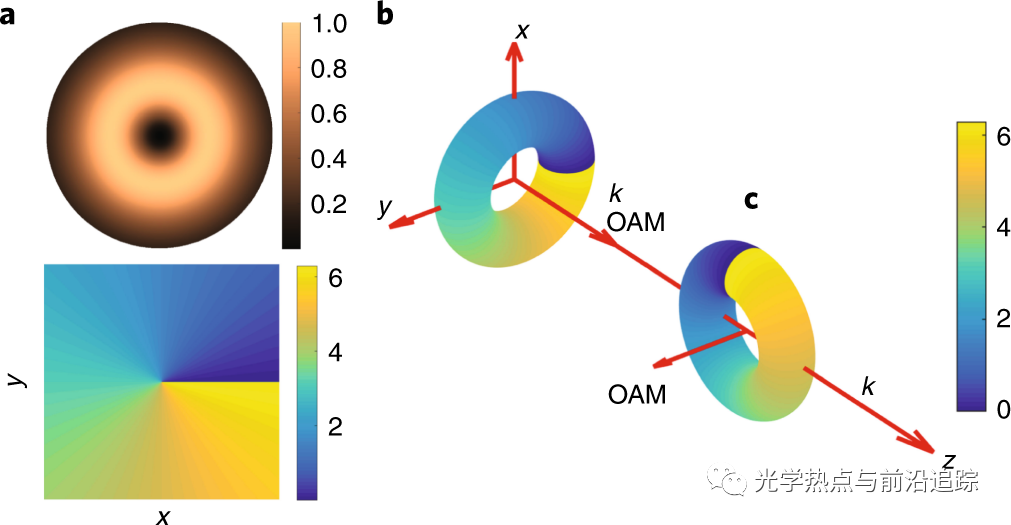
Chong, A., Wan, C., Chen, J. et al. Generation of spatiotemporal optical vortices with controllable transverse orbital angular momentum. Nat. Photonics14, 350–354 (2020).
论文链接: https://doi.org/10.1038/s41566-020-0587-z
3. Ultrafast, sub-nanometre-precision and multifunctional time-of-flight detection
Displacement measurement is a fundamental functionality in modern science and technology. Although there has been remarkable progress in the precision of such measurements with various laser ranging methods, they are incapable of capturing fast and complex mechanical displacements. Here, we have established a displacement measurement method using time-of-flight detection with femtosecond optical pulses and frequency-locked electrical waveforms. This method uniquely combines ultrafast measurement speed, sub-nanometre precision and non-ambiguity range of more than several millimetres. The achieved performance features unprecedented detection speed and precision. Starting from 24 nm precision for 4 ns acquisition time, the precision can reach 180 pm for 5 ms acquisition time. Using this method, we show real-time detection of single-event, fast and high-dynamic-range mechanical displacements. This capability can lead to the realization of new measurement and analysis platforms for studying broadband, transient and nonlinear mechanical dynamics in real time, which will be useful for directly probing optomechanics, the onset of cracks, dynamic deformations, nonlinear vibrations, ultrasonic phenomena and cell-generated forces.
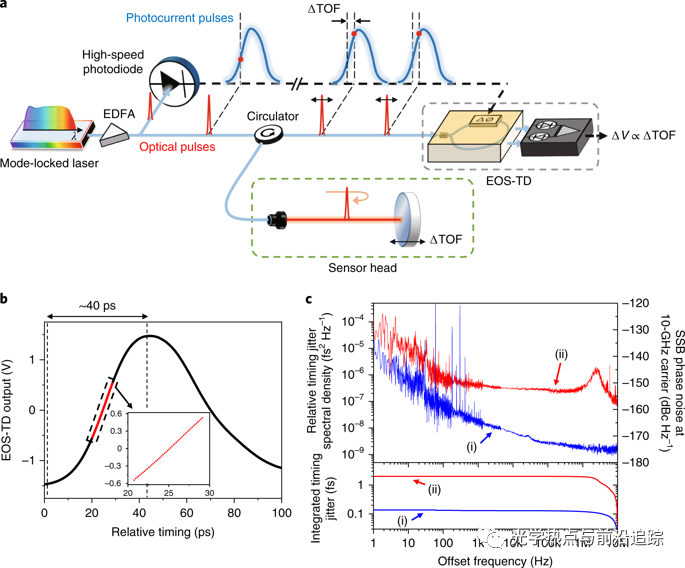
Na, Y., Jeon, C., Ahn, C. et al. Ultrafast, sub-nanometre-precision and multifunctional time-of-flight detection. Nat. Photonics14, 355–360 (2020).
论文链接: https://doi.org/10.1038/s41566-020-0586-0
4. Readout of fluorescence functional signals through highly scattering tissue
Fluorescence is a powerful means to probe information processing in the mammalian brain. However, neuronal tissues are highly heterogeneous and thus opaque to light. A wide set of non-invasive or invasive techniques for scattered light rejection, optical sectioning or localized excitation have been developed, but non-invasive optical recording of activity through a highly scattering layer beyond the ballistic regime is impossible as yet. Here, we show that functional signals from fluorescent time-varying sources located below a highly scattering bone tissue can be retrieved efficiently by exploiting matrix factorization algorithms to demix this information from temporal sequences of low-contrast fluorescence speckle patterns.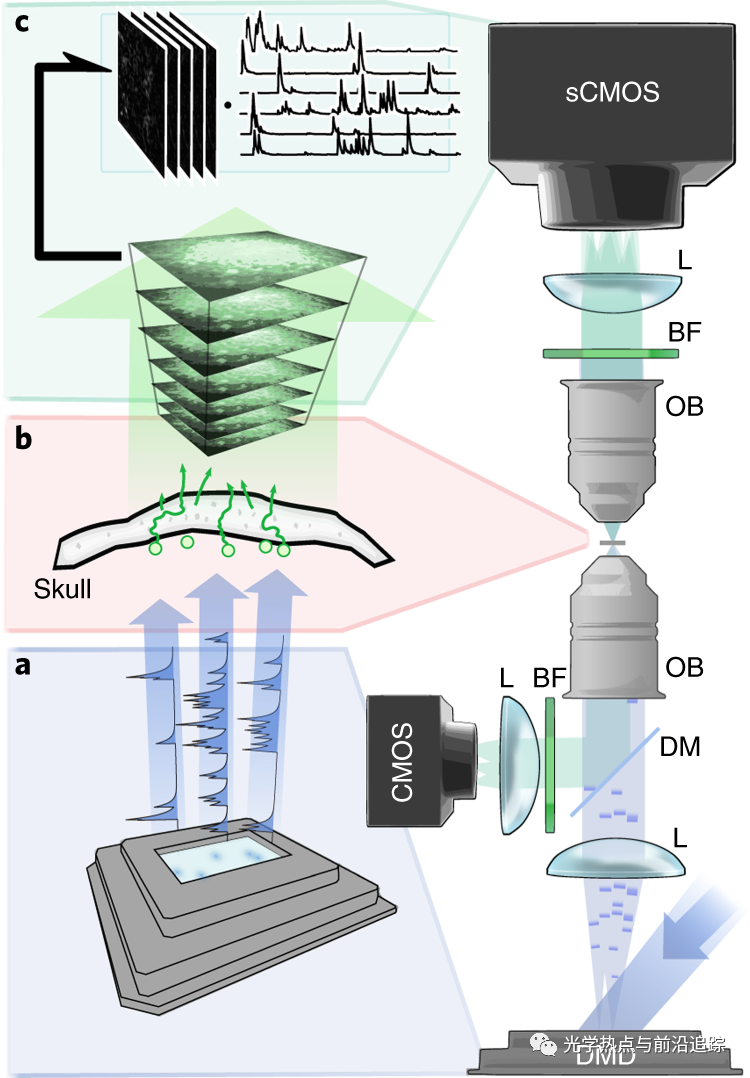
Moretti, C., Gigan, S. Readout of fluorescence functional signals through highly scattering tissue. Nat. Photonics14, 361–364 (2020).
论文链接: https://doi.org/10.1038/s41566-020-0612-2
5. Light-induced magnetism in plasmonic gold nanoparticles
Strategies for the ultrafast optical control of magnetism have been a topic of intense research for several decades because of the potential impact in technologies such as magnetic memory, spintronics and quantum computation, as well as the opportunities for nonlinear optical control and modulation in applications such as optical isolation and non-reciprocity. Here we report experimental quantification of optically induced magnetization in plasmonic gold nanoparticles due to the inverse Faraday effect. The induced magnetic moment is large under typical ultrafast pulse excitation (<1014 W m−2 peak intensity), with magnetization and demagnetization kinetics that are instantaneous within the subpicosecond time resolution of our study. Our results support a mechanism of coherent transfer of angular momentum from the optical field to the electron gas, and open the door to all-optical subwavelength strategies for optical isolation that do not require externally applied magnetic fields.
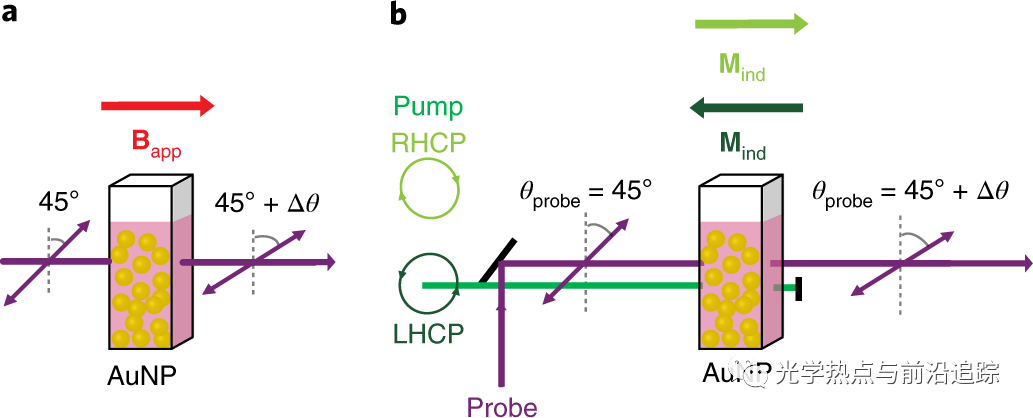
Cheng, O.H., Son, D.H. & Sheldon, M. Light-induced magnetism in plasmonic gold nanoparticles. Nat. Photonics14, 365–368 (2020).
论文链接: https://doi.org/10.1038/s41566-020-0603-3
6. Inverse-designed non-reciprocal pulse router for chip-based LiDAR
Non-reciprocal devices such as isolators and circulators are key enabling technologies for communication systems, both at microwave and optical frequencies. Although non-reciprocal devices based on magnetic effects are available for free-space and fibre-optic communication systems, their on-chip integration has been challenging, primarily due to the concomitant high insertion loss, weak magneto-optical effects and material incompatibility. We show that χ(3)nonlinear resonators can be used to achieve all-passive, low-loss, bias-free non-reciprocal transmission for applications in photonic systems such as chip-scale LiDAR. A multi-port nonlinear Fano resonator is used as an on-chip, non-reciprocal pulse router for frequency comb-based optical ranging. Because time-reversal symmetry imposes stringent limitations on the operating power range and transmission of a single nonlinear resonator, we implement a cascaded Fano–Lorentzian resonator system that overcomes these limitations and substantially improves the insertion loss and operating power range of current state-of-the-art devices. This work provides a platform-independent design for non-reciprocal transmission and routing that is ideally suited for photonic integration.
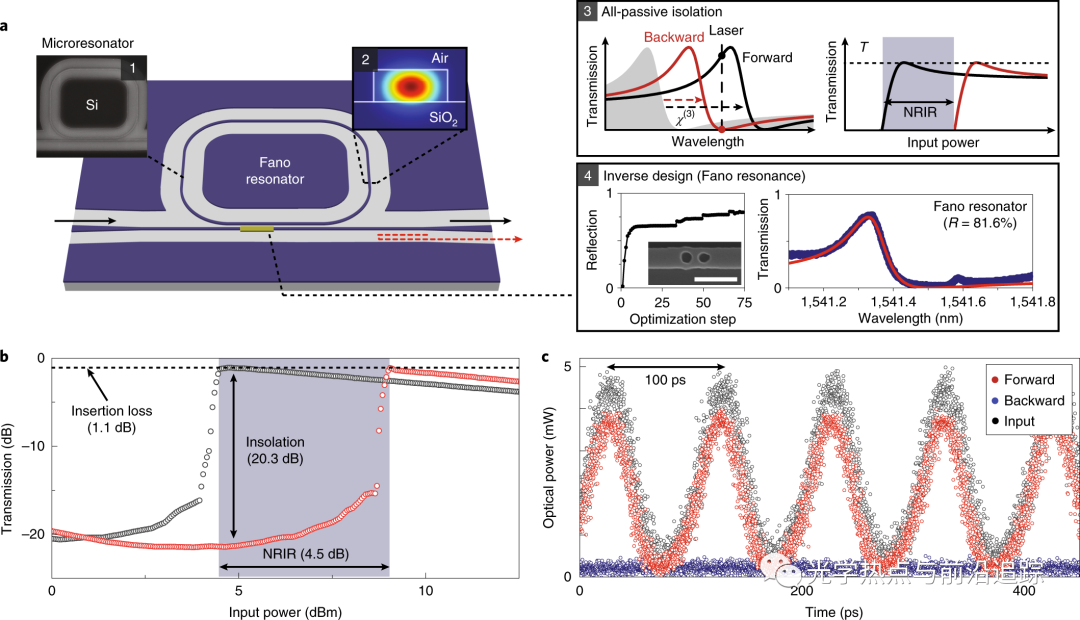
Yang, K.Y., Skarda, J., Cotrufo, M. et al. Inverse-designed non-reciprocal pulse router for chip-based LiDAR. Nat. Photonics14, 369–374 (2020).
论文链接: https://doi.org/10.1038/s41566-020-0606-0
7. Ultra-low-threshold continuous-wave and pulsed lasing in tensile-strained GeSn alloys
Strained GeSn alloys are promising for realizing light emitters based entirely on group IV elements. Here, we report GeSn microdisk lasers encapsulated with a SiNx stressor layer to produce tensile strain. A 300 nm-thick GeSn layer with 5.4 at% Sn, which is an indirect-bandgap semiconductor as-grown, is transformed via tensile strain engineering into a direct-bandgap semiconductor that supports lasing. In this approach, the low Sn concentration enables improved defect engineering and the tensile strain delivers a low density of states at the valence band edge, which is the light hole band. We observe ultra-low-threshold continuous-wave and pulsed lasing at temperatures up to 70 K and 100 K, respectively. Lasers operating at a wavelength of 2.5 μm have thresholds of 0.8 kW cm−2 for nanosecond pulsed optical excitation and 1.1 kW cm−2 under continuous-wave optical excitation. The results offer a path towards monolithically integrated group IV laser sources on a Si photonics platform.
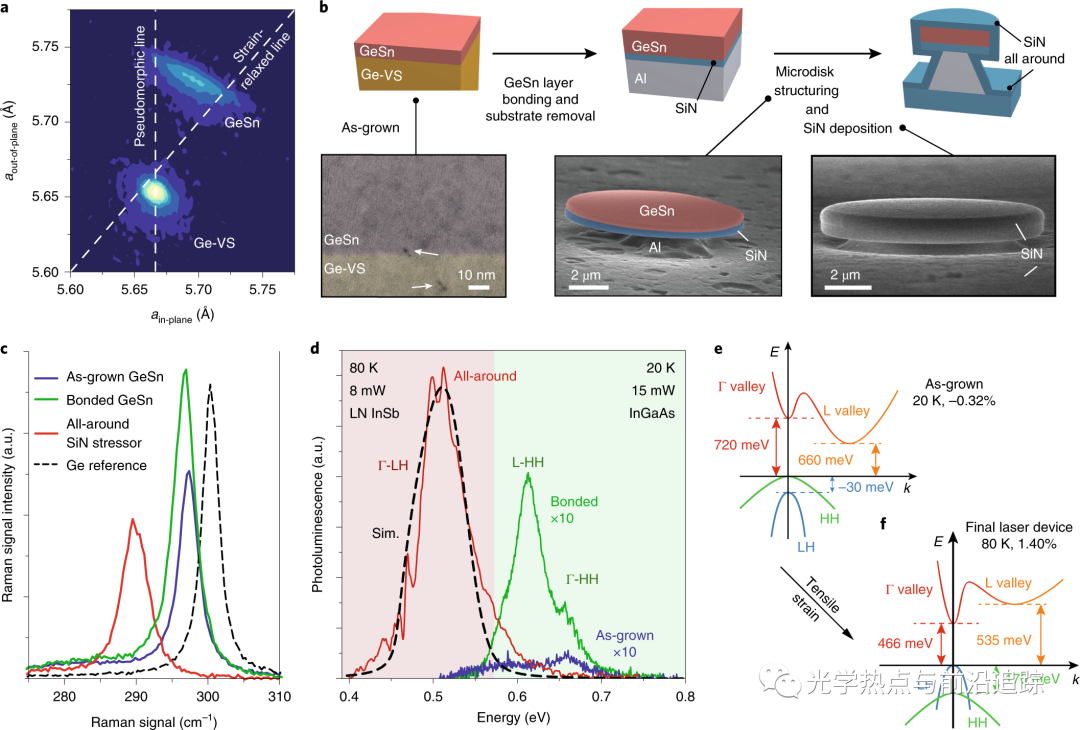
Elbaz, A., Buca, D., von den Driesch, N. et al. Ultra-low-threshold continuous-wave and pulsed lasing in tensile-strained GeSn alloys. Nat. Photonics14, 375–382 (2020).
论文链接: https://doi.org/10.1038/s41566-020-0601-5
8. Deep-learning-enabled self-adaptive microwave cloak without human intervention
Becoming invisible at will has fascinated humanity for centuries and in the past decade it has attracted a great deal of attention owing to the advent of metamaterials. However, state-of-the-art invisibility cloaks typically work in a deterministic system or in conjunction with outside help to achieve active cloaking. Here, we propose the concept of an intelligent (that is, self-adaptive) cloak driven by deep learning and present a metasurface cloak as an example implementation. In the experiment, the metasurface cloak exhibits a millisecond response time to an ever-changing incident wave and the surrounding environment, without any human intervention. Our work brings the available cloaking strategies closer to a wide range of real-time, in situ applications, such as moving stealth vehicles. The approach opens the way to facilitating other intelligent metadevices in the microwave regime and across the wider electromagnetic spectrum and, more generally, enables automatic solutions of electromagnetic inverse design problems.
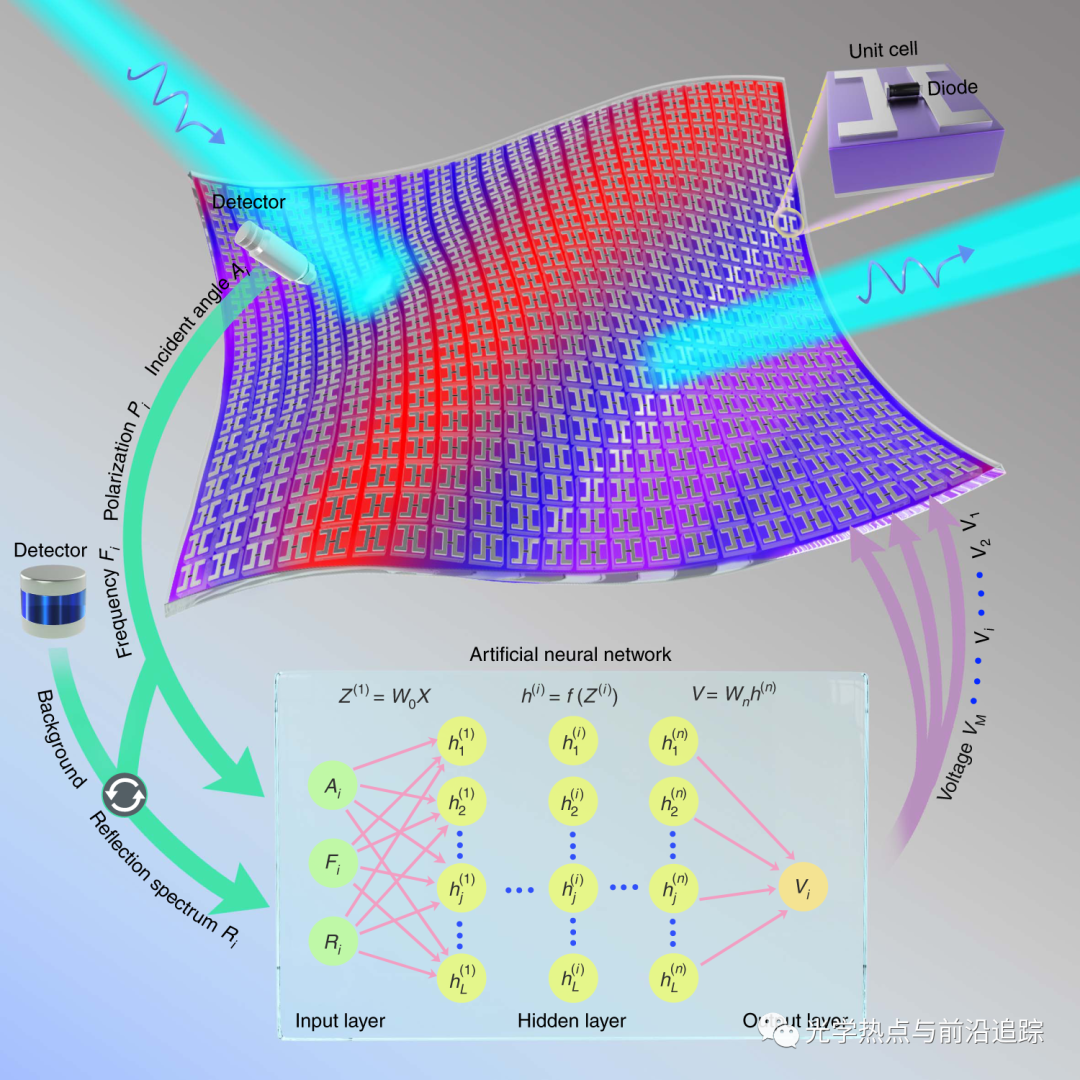
Qian, C., Zheng, B., Shen, Y. et al. Deep-learning-enabled self-adaptive microwave cloak without human intervention. Nat. Photonics14, 383–390 (2020).
论文链接: https://doi.org/10.1038/s41566-020-0604-2
9.A MHz-repetition-rate hard X-ray free-electron laser driven by a superconducting linear accelerator
The European XFEL is a hard X-ray free-electron laser (FEL) based on a high-electron-energy superconducting linear accelerator. The superconducting technology allows for the acceleration of many electron bunches within one radio-frequency pulse of the accelerating voltage and, in turn, for the generation of a large number of hard X-ray pulses. We report on the performance of the European XFEL accelerator with up to 5,000 electron bunches per second and demonstrating a full energy of 17.5 GeV. Feedback mechanisms enable stabilization of the electron beam delivery at the FEL undulator in space and time. The measured FEL gain curve at 9.3 keV is in good agreement with predictions for saturated FEL radiation. Hard X-ray lasing was achieved between 7 keV and 14 keV with pulse energies of up to 2.0 mJ. Using the high repetition rate, an FEL beam with 6 W average power was created.
Decking, W., Abeghyan, S., Abramian, P. et al.A MHz-repetition-rate hard X-ray free-electron laser driven by a superconducting linear accelerator. Nat. Photonics14, 391–397 (2020).
论文链接: https://doi.org/10.1038/s41566-020-0607-z

| Reminder: Beijing Beike New Material Technology Co., Ltd. supplies products only for scientific research, not for humans |
| All rights reserved © 2019 beijing beike new material Technology Co., Ltd 京ICP备16054715-2号 |